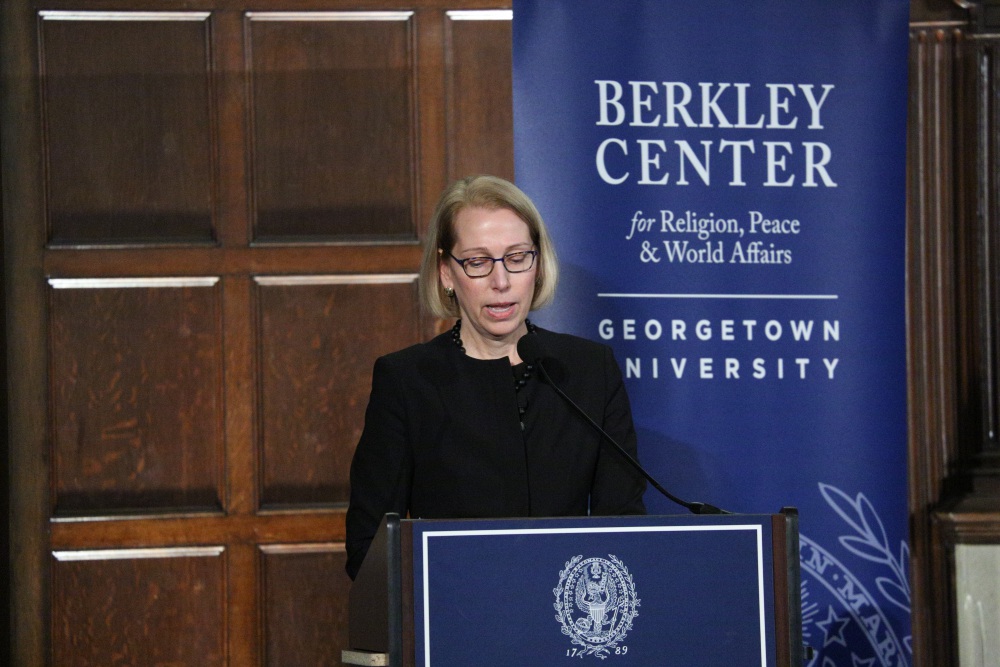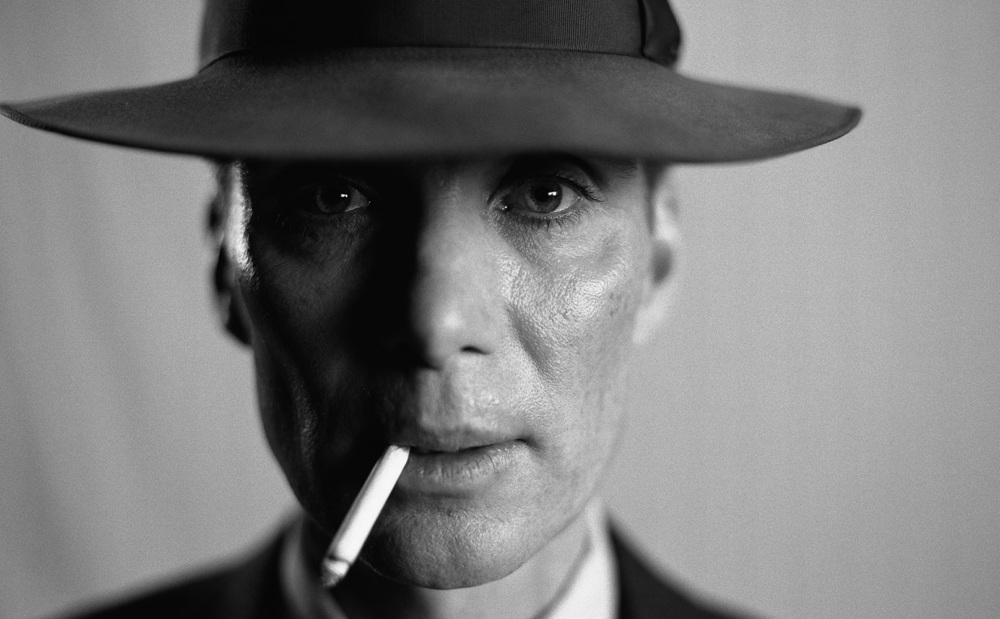
Joan Rohlfing
President and Chief Operating Officer, NTI
Good evening. I want to thank President DeGioia, Drew Christiansen, the Berkley Center and all the co-sponsors of tonight’s event for convening this important conversation and inviting me to reflect on this challenging topic.
My own convictions have developed over a lifetime of close engagement with the global nuclear deterrence system. And my remarks this afternoon are based on my more than 34 years of experience working both inside the US Government, and in the NGO sector to reduce the risk that a nuclear weapon will ever be used again. In particular, I want to share my perspective on what is needed now to achieve essential progress on nuclear disarmament.
But first, I want to underscore how much I appreciate Archbishop Tomasi’s presentation. The Church’s affirmation that the use, threat of use and even possession of nuclear weapons is immoral, and its rejection of the doctrine of deterrence challenges us all to rethink our assumptions and approaches for protecting humanity. The views of the leaders of the church expressed by the Archbishop are fully consistent with my own critique about how deterrence theory is irrelevant to many of today’s threats.
Designed more than 60 years ago, nuclear deterrence strategy is hopelessly outdated, and is now increasing the danger it was designed to address. In how many other fields do leaders, experts, and practitioners rely on 60-year-old thinking, despite fundamental changes to the threat and technology environments?
Why is this a problem?
Why is this a problem? Simply put, because the world has changed significantly. Today the risk of nuclear use is not primarily driven by the failure to deter the intentional use of NWs.
It is driven by cyber-threats, new technologies, increasingly sophisticated terrorist groups, and with 9 nuclear states, a more complex global playing field.
Imagine, in the midst of a crisis with Russia, if the President were to receive warning from our military that there were several hundred nuclear missiles inbound toward the United States, and under the severe time pressure of only minutes, decided to launch a retaliatory strike using US nuclear weapons, only to learn a few minutes after launch, that our US warning systems had been spoofed by a sophisticated cyber-attack.
The primacy we assign to deterrence strategy compounds the very nuclear danger it was designed to address.
Specifically, nuclear deterrence, in its current form, has been used to:
These practices are escalating the risk of catastrophic nuclear use. We are at a highly dangerous moment – and moving in the wrong direction.
The Burden of Change: Time for New Thinking
This year, we mark the 75th anniversary of the creation and only use of the bomb. It is time to reinvent the way we think about nuclear risks if we are to prevent the use of nuclear weapons for another 75 years.
We need a new approach to nuclear strategy, one that doesn’t wager our collective future on the assumption that nuclear weapons operate in a system with rational players, perfect information and infallible technology—in perpetuity.
We know the game-theory based deterrence model is flawed: humans make mistakes, behave irrationally, and can receive faulty, misleading or incomplete information; equipment fails; and terrorists aren’t deterred. New technologies, like cyber weapons and hypersonic delivery systems complicate the risk equation further.
How to make progress?
Why has progress been so difficult to achieve? I see three principal reasons:
On this issue of strategy for advancing disarmament…
In the past, the nuclear threat reduction community, including NTI, has primarily focused on influencing nuclear policy and practices through outreach to government decision- makers, both military and civilian. Governments have focused on international legal arrangements. The Church has done so too, but this approach alone has proven inadequate.
Indeed, the international arrangements the world created to regulate nuclear weapons are being torn down, and at the same time citizens have become largely divorced from nuclear issues around the world. It’s ironic, isn’t it, that as a society, we have become almost completely ignorant and voiceless about nuclear threats and nuclear justice, even as the urgency of the threat and the risks have grown.
This reality has caused NTI to explore new approaches to effecting change including through cultural shifts.
What does that mean? It means building political will for change. It means building awareness of the threat, and the terrible risks inherent in our nuclear weapons. It means building a new set of ethical principles to guide the strategy of the future. It’s about better aligning peoples’ understanding about nuclear weapons with the reality of the extremely high risks and unacceptable consequences of their use, instead of seeing them as artifacts of power and security.
NTI has begun some initial work in this field by starting a public education program in Iowa and New Hampshire to take advantage of the presence of presidential candidates, a heavy media presence, and town hall events to do some education. As part of that work, we engaged Hart Research to do some polling, and they found 84% of engaged voters in key states say it’s “essential” or “very important” for presidential candidates to have plans or policies to reduce the threats related to nuclear weapons. What’s more: the demand for candidates to address these threats cut across party lines with 87% of these Democrats and 81% of these Republicans saying they would respond more favorably toward a candidate who put a high priority on reducing nuclear threats.
One significant challenge that those of us in civil society share with you in the church is how we translate our vision of a disarmed world into action steps around the world. As a fellow co-struggler on the journey toward disarmament, I can see how the Catholic Church has a major capacity to shape the moral and the cultural conversation around nuclear weapons.
I urge the leaders and laity of the church to advance your message about nuclear peace and justice, about the immorality of nuclear weapons and the inadequacy of nuclear deterrence, to push out this message globally at the parish level through the pulpit. I am drawn to an image of the future in which the immorality of nuclear use and possession are woven into the fabric of parish level teaching, prayers and knowledge that shape society’s cultural and moral views.
What if the Catholic Church truly leveraged its reach, power and moral authority to help humanity reach its glorious potential and achieve justice for both current and future generations? The force of the church has played such a strong and positive role in other areas, such as immigration and poverty. We are all familiar with the great work of Catholic Relief Services around the world. Wouldn’t it be great if the Church’s force could be brought to bear on nuclear disarmament? What might a Catholic Disarmament Service look like? Perhaps it would include great universities like Georgetown and Notre Dame deploying their capacities for research, teaching, and broader institutional agency to prevent nuclear war.
You have access to a huge reservoir of expertise to support such parish initiatives. Expertise that does not exist in the hierarchy can be found readily in the pews, both within the church itself through the expertise of your membership, as well as from civil society more broadly.
A parish-level peacemaking initiative, that works to embody the concept of integral disarmament and to advance peacemaking in the hearts and minds of every individual in the parish would drive us a huge step forward in creating the fundamental conditions needed for policy and political change.
As I mentioned at the outset, I have been committed to the field of global nuclear security for more than three decades—and today, I am energized by and enormously grateful for the Church’s commitment to making a difference in this space. We at NTI—and I know the entire disarmament community—are ready to support and promote your efforts. I appreciate the invitation to join you tonight and look forward to our ongoing conversation.
Sign up for our newsletter to get the latest on nuclear and biological threats.
There is a critical need for a global diplomatic approach to address growing cyber risks, including, where possible, through cooperation between the United States and Russia.
“The bottom line is that the countries and areas with the greatest responsibility for protecting the world from a catastrophic act of nuclear terrorism are derelict in their duty,” the 2023 NTI Index reports.
Christopher Nolan's Oppenheimer is the most high-profile film about nuclear weapons ever made.



